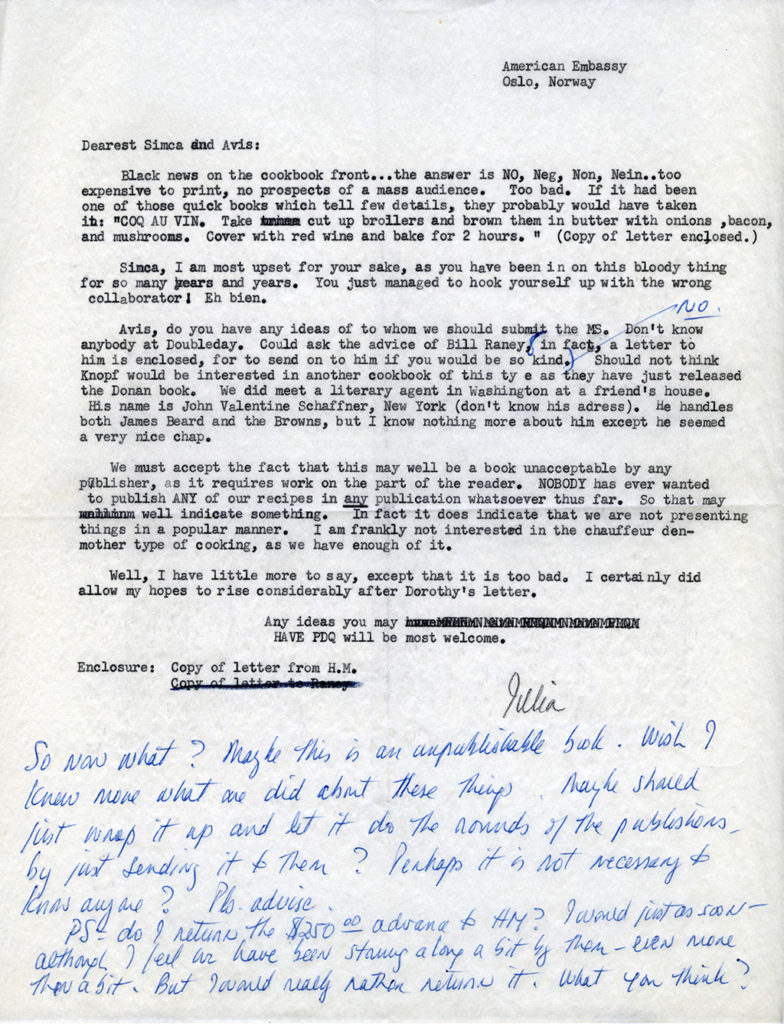In the midst of reading As Always: The Letters of Julia Child and Avis DeVoto by Joan Reardon, and while separately reading of Mark Twain’s two-week experience as an amateur and eventually too-reluctant Confederate soldier, I discovered an interesting connection.
Avis DeVoto’s husband, Bernard DeVoto, had written an article in Harper’s on the difficulty of finding good kitchen knives in the US – this was in the early 1950s. That article is what prompted Julia to write; he was fairly busy at the time, so his wife answered instead with a four-page letter.
Thus began a long correspondence and friendship, and something else that was momentous. Avis had connections in the publishing world that eventually led to the release of Mastering the Art of French Cooking by Knopf in 1961, nine years after Julia and Avis first exchanged letters in 1952.
The unusual connection I wasn’t aware of until just now – or, rather, for which I hadn’t yet connected the dots – is that Bernard, a historian, was an authority on Mark Twain who curated and edited Twain’s papers. He edited a few books of Twain’s work, including the still in print The Portable Mark Twain, one of the first Twain volumes I read many years ago. Before I knew of the Child connection, I only recently bought DeVoto’s Mark Twain’s America, originally published in 1932, to get a better sense of what the country was like at the times of Twain’s travels.
The final connection is a mention of a particular type of cooking in Virginia City, Nevada, where Twain lived in the early 1860s, from just that volume:
They came to Virginia City as soon as the true value of the Comstock was perceived. They constituted, no doubt, a deplorable source of gambling, pleasure and embroilment. They were not soft-spoken women, their desire was not visibly separate from the main chance, and they would have beheld Mr. Harte’s portrayal of them at Poker Flat with ribald mirth. But let them have a moment of respect. They civilized the Comstock. They drove through its streets reclining in lacquered broughams, displaying to male eyes fashions as close to Paris as any then current in New York. They were, in brick houses hung with tapestries, a glamour and a romance, after the superheated caverns of the mines. They enforced a code of behavior: one might be a hard-rock man outside their curtains but in their presence one was punctilious or one was hustled away. They brought Parisian cooking to the sagebrush of Sun Mountain and they taught the West to distinguish between tarantula juice* and the bouquet of wines. An elegy for their passing. The West has neglected to mention them in bronze and its genealogies avoid comment on their marriages, conspicuous or obscure, but it owes them a here acknowledged debt for civilization.
*Tarantula juice was one of the many names for bastardised whisky in that corner of Nevada, cut with rather novel ingredients. According to J. Ross Browne in the January 1861 edition of Harper’s, “The whisky contained strychnine, oil of tobacco, tarantula juice, and various effective poisons of the same general nature, including a dash of corrosive sublimate; and the gin was manufactured out of turpentine and whisky, with a sprinkling of Prussic acid to give it flavor.”
Apparently, strychnine, deadly in higher quantities, would, in smaller quantities, produce effects not unlike those of methamphetamine. In 1864, Twain wrote of the Dashaway Association, a temperance group started by a group of San Francisco volunteer firemen in 1859. He said its ranks were increasing because the new adherents “fear strychnine more than inebriation.”

